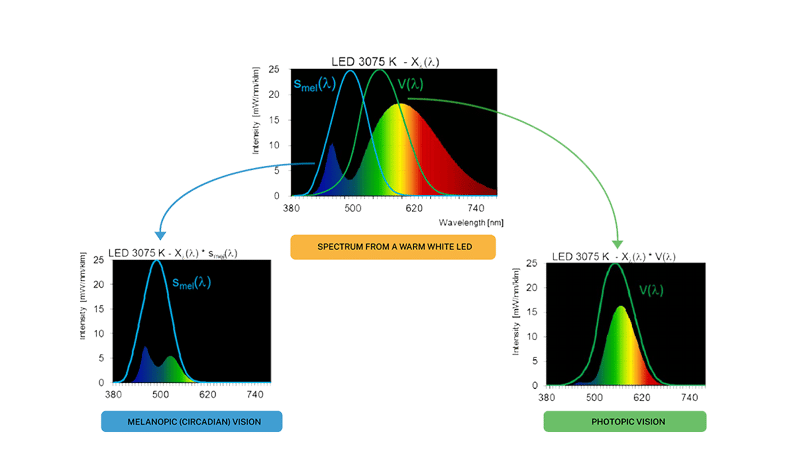In simple terms, Melanopic EDI, which stands for Melanopic Equivalent Daylight Illuminance, explains how much a light source affects the non-visual system of humans, including our circadian rhythm. The somewhat cryptic name indicates that the unit consists of an equivalent. It is a metric that determines how much daylight is needed to produce the same impact as the measured lighting setting.
The Origins of Melanopic EDI
Every light source and lighting setting has a unique impact on both our vision and circadian rhythm. Traditionally, the measurement of light in the lighting industry has been based on visual parameters such as illuminance (lux), which measures the intensity of light as perceived by the visual system. This approach was rooted in the belief that the human eye only contained image-forming photoreceptor cells in the retina, thus focusing solely on visual perception. However, in 2002, researchers discovered the existence of specialized cells in the human eye called intrinsically photosensitive retinal ganglion cells (ipRGCs). These cells are not involved in forming images but instead play a crucial role in our circadian rhythm as they are able to perceive the time of day, contributing to our overall health and well-being. The discovery of ipRGCs laid the foundation for the metric known as Melanopic EDI.
Melanopsin as the Marker
A specialized photopigment known as melanopsin is on the surface of ipRGC cells. Melanopsin can be described as a type of light meter in the retina that is responsible for adjusting our circadian rhythm. When researchers needed a scale to measure light's influence on the circadian rhythm, they discovered that melanopsin was the best marker. Melanopsin is highly sensitive to blue light, and this sensitivity is taken into account in Melanopic EDI.
Melanopic EDI is based on the fact that exposure to blue light in the evening and at night causes melanopsin (our regulator of the circadian rhythm) to send a signal to our brain that it is still daytime. This prevents the secretion of our 'hormone of darkness', melatonin, which plays a crucial role in keeping the body healthy and the circadian rhythm intact. In other words, Melanopic EDI is a scale that enables us to ensure that the lighting environment we are surrounded by is sensitive to our fundamental need for a light-dark cycle – a circadian rhythm. However, there is a problem.

Melanopic EDI, defined by the international standardization organization CIE, does not directly measure the sensitivity of melanopsin, as the units in the SI system do not include this sensitivity. Instead, the metric is designed to measure the impact on circadian rhythm by comparing a lighting setting to daylight.
Researchers Take the Lead
Years of intensive research have resulted in a consensus publication*, where researchers in the field have put forth a series of recommendations emphasizing the importance of high Melanopic EDI during the daytime and low to no Melanopic EDI at night. One thing is certain: By quantifying Melanopic EDI, researchers and lighting professionals can assess the potential impact of different light sources on the circadian rhythm. This means they can make informed decisions about lighting design and implementation based on the measurement, benefiting the users. So, without a doubt, Melanopic EDI is a highly significant attribute of light that will become even more widely utilized in the future.
*Brown TM, Brainard GC, Cajochen C, Czeisler CA, Hanifin JP, Lockley SW, et al. (2022) Recommendations for daytime, evening, and nighttime indoor light exposure to best support physiology, sleep, and wakefulness in healthy adults. PLoS Biol 20(3): e3001571. https://doi.org/10.1371/journal.pbio.3001571

